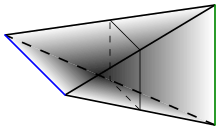Join (topology)
In topology, a field of mathematics, the join of two topological spaces A and B, often denoted by or , is defined to be the quotient space

Geometric join of two line segments. The original spaces are shown in green and blue. The join is a three-dimensional solid in gray.
where I is the interval [0, 1] and R is the equivalence relation generated by
At the endpoints, this collapses to and to .
Intuitively, is formed by taking the disjoint union of the two spaces and attaching line segments joining every point in A to every point in B.
Examples
- The join of a space X with a one-point space is called the cone CX of X.
- The join of a space X with (the 0-dimensional sphere, or, the discrete space with two points) is called the suspension of X.
- The join of the spheres and is the sphere .
- The join of two pairs of isolated points is a square (without interior). The join of a square with a third pair of isolated points is an octahedron (again, without interior). In general, the join of n+1 pairs of isolated points is an n-dimensional octahedral sphere.
- The join of two abstract simplicial complexes X and Y on disjoint vertiex sets is the abstract simplicial complex . I.e., any simplex in the join is the union of a simplex from X and a simplex from Y. For example, if each of X and Y contain two isolated points, X = { {1}, {2} } and Y = { {3}, {4} }, then X * Y = { {1,3} , {1,4} , {2,3} , {2,4} } = a "square" graph.
Properties
- The join of two spaces is homeomorphic to a sum of cartesian products of cones over the spaces and the spaces themselves, where the sum is taken over the cartesian product of the spaces:
- Given basepointed CW complexes (A,a0) and (B,b0), the "reduced join"
is homeomorphic to the reduced suspension
of the smash product. Consequently, since is contractible, there is a homotopy equivalence
gollark: Again, probably not several hundred kilo$ in benefit there.
gollark: I mean, yes, but possibly not several hundred kilodollars handy.
gollark: There are likely HEAVY diminishing returns.
gollark: I really doubt the education varies *that much*, yes.
gollark: I assume you plan to summon money from the void.
See also
References
- Hatcher, Allen, Algebraic topology. Cambridge University Press, Cambridge, 2002. xii+544 pp. ISBN 0-521-79160-X and ISBN 0-521-79540-0
- This article incorporates material from Join on PlanetMath, which is licensed under the Creative Commons Attribution/Share-Alike License.
- Brown, Ronald, Topology and Groupoids Section 5.7 Joins.
This article is issued from Wikipedia. The text is licensed under Creative Commons - Attribution - Sharealike. Additional terms may apply for the media files.